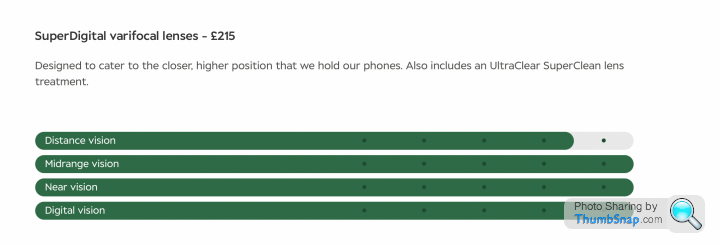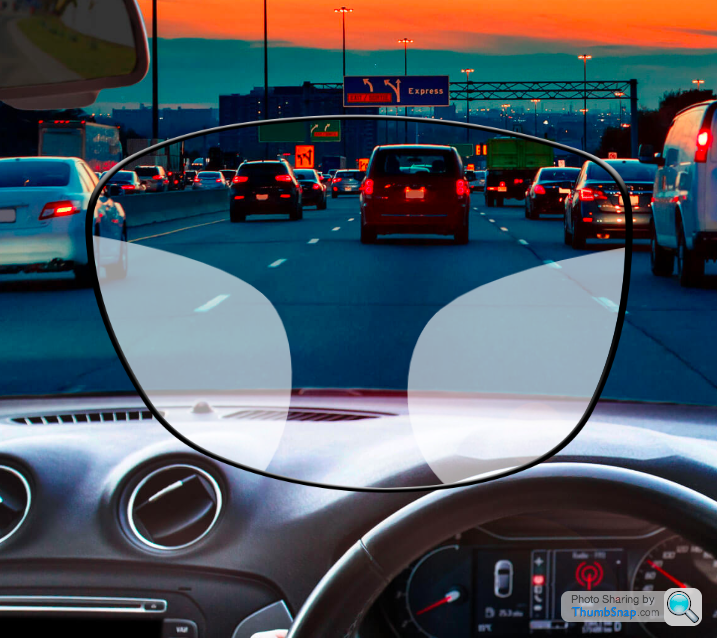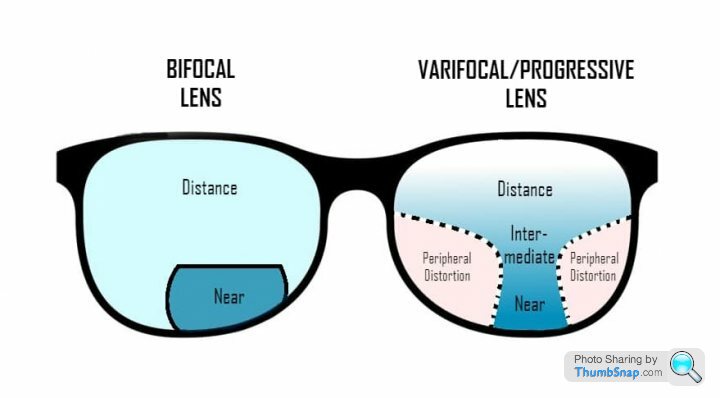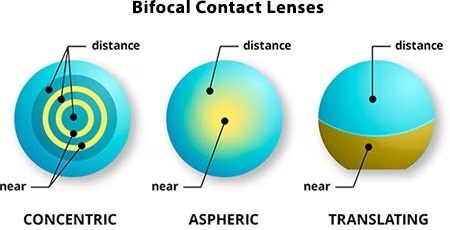Specsavers SuperDrive/SuperDigital lenses
Discussion
Anyone using either of these varifocal lenses?
I'm about to get my first pair of varifocals, never had them before. I'm getting fed up with swapping between my reading and distance glasses when watching TV or sat with my laptop/phone. My distance glasses are ok for driving but not for seeing the dashboard. My reading glasses aren't now suitable for watching TV as they once were. Hoping varifocals with tick all boxes.
My employer offers free eye tests and glasses vouchers with Specsavers, so my hands are sort of tied with using them. I see they do SuperDrive and SuperDigital lenses but have no experience of them.


I'm about to get my first pair of varifocals, never had them before. I'm getting fed up with swapping between my reading and distance glasses when watching TV or sat with my laptop/phone. My distance glasses are ok for driving but not for seeing the dashboard. My reading glasses aren't now suitable for watching TV as they once were. Hoping varifocals with tick all boxes.
My employer offers free eye tests and glasses vouchers with Specsavers, so my hands are sort of tied with using them. I see they do SuperDrive and SuperDigital lenses but have no experience of them.


I don't use Specsavers but that's not relevant in this case.
Personally I'd prefer the design that increases the area for distance and mid range, but that's me.
If the dispenser is worth their salt, not always the case, then they should have that discussion with you about best designs based on your prescription and typical use.
Note particularly for varifocals it's absolutely vital that they get the measurements, glazing and fitting right so that the optical centre of the lens is positioned correctly. Most issues result from failure to get that right.
Personally I'd prefer the design that increases the area for distance and mid range, but that's me.
If the dispenser is worth their salt, not always the case, then they should have that discussion with you about best designs based on your prescription and typical use.
Note particularly for varifocals it's absolutely vital that they get the measurements, glazing and fitting right so that the optical centre of the lens is positioned correctly. Most issues result from failure to get that right.
Point taken about the measurements and fitting, thanks.
I went into my local Specsavers this afternoon, seems the difference between all their varifocals is the size of the blurred unfocussed section of the lens. The SuperDigital and SuperDrive having smaller unfocussed areas, and with SuperDrive having a full width band of distance vision area.
With the frames I'm considering they do a 2 for 1, and can mix & match the glasses, so I might go for a pair of their SuperDigital for when using my laptop, watching TV and working at the computer, and also a pair of SuperDrive to keep in the car. Of course it's extra ££ for reactive lenses for when it's sunny, but that might be neededl for the driving pair.
It might all be a bit of a gimmick, but I've got to jump in at some point.
SuperDrive

I went into my local Specsavers this afternoon, seems the difference between all their varifocals is the size of the blurred unfocussed section of the lens. The SuperDigital and SuperDrive having smaller unfocussed areas, and with SuperDrive having a full width band of distance vision area.
With the frames I'm considering they do a 2 for 1, and can mix & match the glasses, so I might go for a pair of their SuperDigital for when using my laptop, watching TV and working at the computer, and also a pair of SuperDrive to keep in the car. Of course it's extra ££ for reactive lenses for when it's sunny, but that might be neededl for the driving pair.
It might all be a bit of a gimmick, but I've got to jump in at some point.
SuperDrive

Edited by The Gauge on Saturday 2nd March 20:24
FiF said:
Somebody said:
As mentioned, getting the Pupillary Distance measurement right is key.
There's a lot more to it than just the PD. A lot more.….although my last two pairs of varifocal specs came from an online retailer, & I measured my PD myself (with family help)….
….did I get lucky, or maybe there isn’t so much more?
mikeiow said:
FiF said:
Somebody said:
As mentioned, getting the Pupillary Distance measurement right is key.
There's a lot more to it than just the PD. A lot more.….although my last two pairs of varifocal specs came from an online retailer, & I measured my PD myself (with family help)….
….did I get lucky, or maybe there isn’t so much more?
The online retailer will have just used population standards for other measurements that are important to the fitting, these may well have worked for you, your prescription may not be particularly strong nor complicated, in which case can get away with it.
Vertex distance, fitting height, pantoscopic tilt, positive facial wrap, any other oddities, maybe ears not at same height, more common than you might think. Or maybe holding head in an odd position while being measured.
But if you want to continue to think there's nothing much more to it than PD, will leave you to stew in your ignorance.
I got my first pair of varifocals a month ago (I’m 52); Specsavers Super Digital.
Based on my limited experience so far, I’m pretty happy with them. Only downside is if I am slouched or lying down on the sofa trying to watch TV through the bottom half of the lenses, that obviously doesn’t work. Other than that, all the various focal ranges seem to be in the right places where my eyes would expect them to be, so they are generally very user friendly. The person dispensing them did spend AGES checking and double checking all the measurements. Driving is fine, by the way.
On a related note, have you tried multi focal contacts? These work in a very different way to varifocal glasses but produce similar results i.e. allow you to see both far and near. I’ve got these too and really like them; very good in all but low light. Might be worth considering instead of (or alongside) varifocals (plus you can wear normal sunglasses, etc.).
Based on my limited experience so far, I’m pretty happy with them. Only downside is if I am slouched or lying down on the sofa trying to watch TV through the bottom half of the lenses, that obviously doesn’t work. Other than that, all the various focal ranges seem to be in the right places where my eyes would expect them to be, so they are generally very user friendly. The person dispensing them did spend AGES checking and double checking all the measurements. Driving is fine, by the way.
On a related note, have you tried multi focal contacts? These work in a very different way to varifocal glasses but produce similar results i.e. allow you to see both far and near. I’ve got these too and really like them; very good in all but low light. Might be worth considering instead of (or alongside) varifocals (plus you can wear normal sunglasses, etc.).
Edited by chemistry on Sunday 3rd March 18:26
chemistry said:
I got my first pair of varifocals a month ago (I’m 52); Specsavers Super Digital.
Based on my limited experience so far, I’m pretty happy with them. Only downside is if I am slouched or lying down on the sofa trying to watch TV through the bottom half of the lenses, that obviously doesn’t work. Other than that, all the various focal ranges seem to be in the right places where my eyes would expect them to be, so they are generally very user friendly. The person dispensing them did spend AGES checking and double checking all the measurements. Driving is fine, by the way.
On a related note, have you tried multi focal contacts? These work in a very different way to varifocal glasses but produce similar results i.e. allow you to see both far and near. I’ve got these too and really like them; very good in all but low light. Might be worth considering instead of (or alongside) varifocals (plus you can wear normal sunglasses, etc.).
Thanks for your feedback, reassuring that you get on with the SuperDigital lenses. I haven't tried any type of contacts yet, I think that whilst I'm not yet needing to wear glasses 24/7 I'll stick to just putting on the varifocals as and when I need them.Based on my limited experience so far, I’m pretty happy with them. Only downside is if I am slouched or lying down on the sofa trying to watch TV through the bottom half of the lenses, that obviously doesn’t work. Other than that, all the various focal ranges seem to be in the right places where my eyes would expect them to be, so they are generally very user friendly. The person dispensing them did spend AGES checking and double checking all the measurements. Driving is fine, by the way.
On a related note, have you tried multi focal contacts? These work in a very different way to varifocal glasses but produce similar results i.e. allow you to see both far and near. I’ve got these too and really like them; very good in all but low light. Might be worth considering instead of (or alongside) varifocals (plus you can wear normal sunglasses, etc.).
FiF said:
mikeiow said:
FiF said:
Somebody said:
As mentioned, getting the Pupillary Distance measurement right is key.
There's a lot more to it than just the PD. A lot more.….although my last two pairs of varifocal specs came from an online retailer, & I measured my PD myself (with family help)….
….did I get lucky, or maybe there isn’t so much more?
The online retailer will have just used population standards for other measurements that are important to the fitting, these may well have worked for you, your prescription may not be particularly strong nor complicated, in which case can get away with it.
Vertex distance, fitting height, pantoscopic tilt, positive facial wrap, any other oddities, maybe ears not at same height, more common than you might think. Or maybe holding head in an odd position while being measured.
But if you want to continue to think there's nothing much more to it than PD, will leave you to stew in your ignorance.
Re-read my last line and feel free to drop back here. Hint….maybe just say “you got lucky”.
FiF said:
Vertex distance, fitting height, pantoscopic tilt, positive facial wrap, any other oddities, maybe ears not at same height, more common than you might think. Or maybe holding head in an odd position while being measured.
Both wife and I have had several pairs of varifocals and don't recall any great fitting drama beyond centres and heights.I will say the very first pairs we got, from Specsavers, were done by a dispenser who somehow seemed very competent and for both of us they just worked straight off. We had two pairs, one with Essilor Panamic lenses and the other with "Pentax" - the name Specsaver were using at the time for their own brand, with photochromic lenses. Couldn't tell the difference between them and even today I find those Pentax glasses the most optically comfortable of any of my other pairs.
One of the subsequent pairs I got had lenses with a "split prism" which apparently evens up the thin/thicknes of the lenses but I found things jumped about. They said some people are OK with them and some aren't, but they replaced the lenses in both sets without question.
I suspect that some of the satisfaction factor relates to expectations.
Varifocals (like all optical devices) are a compromise. For the benefit of getting near, intermediate and far vision in one set of glasses with no obvious 'bifocal line' you sacrifice some areas of the lens i.e. the 'blurry zones'. The better the lens, the better the fit and depending on one's prescription, how much of a compromise this represents will vary.
My varoifoicals seem fine...I can see near, far and intermediate and 99% I don't seem consciously have to look through a certain part of the lens. That said, for pure distance, then regular single vision lenses would undoubtedly be better, etc. For me, so far, the compromise seems worth it.
Varifocals (like all optical devices) are a compromise. For the benefit of getting near, intermediate and far vision in one set of glasses with no obvious 'bifocal line' you sacrifice some areas of the lens i.e. the 'blurry zones'. The better the lens, the better the fit and depending on one's prescription, how much of a compromise this represents will vary.
My varoifoicals seem fine...I can see near, far and intermediate and 99% I don't seem consciously have to look through a certain part of the lens. That said, for pure distance, then regular single vision lenses would undoubtedly be better, etc. For me, so far, the compromise seems worth it.
chemistry said:
....Only downside is if I am slouched or lying down on the sofa trying to watch TV through the bottom half of the lenses, that obviously doesn’t work.....
I agree with the slouching while watching TV (as that's what I do) and I also find that keeping your eye on the 'subject' while going for a pee is difficult! Its all a bit blurred.The Gauge said:
So compared to varifocals, are bifocals annoying with the distinctive line between the gradients? Are varifocals a lot better than bifocals? I assume bifocals by their very name just have two zones - reading & distance, with no intermediate zone?
I’m not an optician, but as I understand it, this is a pretty good comparison:
So again, compromise. Bifocals have a bigger useful are of lens but no intermediate zone and a visible ‘close focus’ segment that is obvious to others. Varifocals have distance, near and intermediate zones and look like normal glasses (no bifocal line/segment) but have ‘wasted’ sections at the sides.
You pay your money and take your choice! Everything is a compromise.
Edited by chemistry on Monday 4th March 20:57
Digger said:
How on earth do varifocal contact lenses work?
Do they rely on your eyelids shifting the lenses slightly upwards when looking down to read something so that the "reading" prescription gets involved?
As I understand it (as a wearer) they have the main lens (distance) and on top of that is etched a fresnel diffraction lens (near). Your eyes/brain then receive a sharp AND blurred image and just discard the blurred one.Do they rely on your eyelids shifting the lenses slightly upwards when looking down to read something so that the "reading" prescription gets involved?
I’ve got them and they work well. Only issue is low light, when I think the pupil gets too big to make proper use of the near image (so in a dim restaurant I’d still need reading glasses to read small print on a menu). 90% of the time they are great though, in all normal/bright light. Sort of the equivalent of having my 30 year old eyes back (rather than my 20 year old ones, sadly!).
Another option - which didn’t work for me - is mono vision, where you have a distance lens in one eye and a near lens in the other.
[Edit…turns out there are various types…]

Edited by chemistry on Monday 4th March 21:16
Edited by chemistry on Monday 4th March 21:17
Edited by chemistry on Monday 4th March 21:19
Gassing Station | Health Matters | Top of Page | What's New | My Stuff



